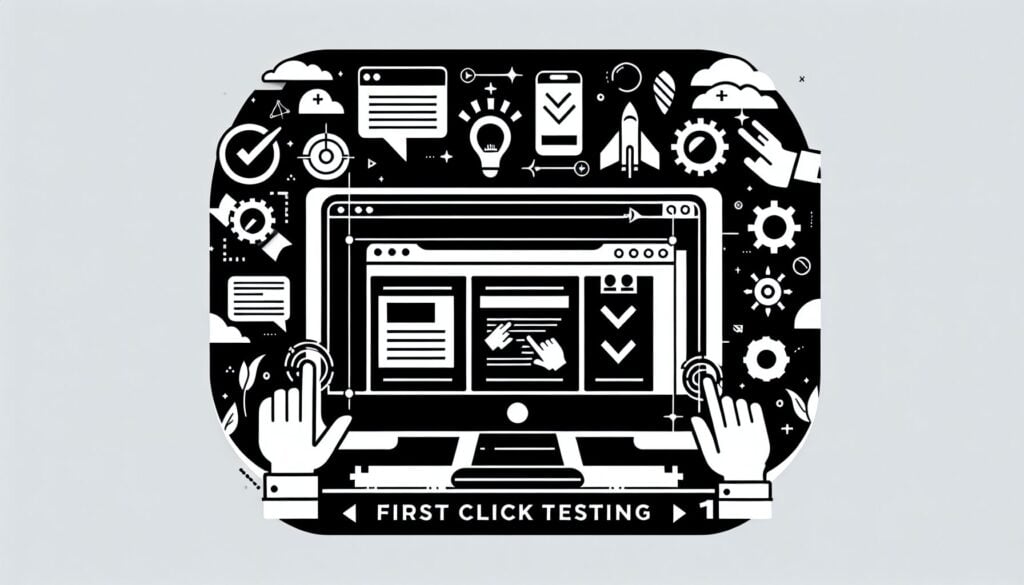A usability testing method that evaluates the effectiveness of a website’s navigation and بنية المعلومات by tracking where a user would click first to complete a specific task.
- المنهجيات: العملاء والتسويق, الاقتصاد, تصميم المنتج
First Click Testing

First Click Testing
- التفكير التصميمي, هندسة المعلومات, التصميم التفاعلي, سهولة الاستخدام, اختبار قابلية الاستخدام, تجربة المستخدم (UX), واجهة المستخدم (UI), اختبار المستخدم, تصميم يركز على المستخدم
الهدف:
كيفية استخدامه:
- Participants are given a task and shown an image of a webpage (or prototype). They are asked to click where they would go first to try and complete the task. Success rates and click locations are recorded.
الايجابيات
- Quick and inexpensive to conduct; can be done with wireframes or mockups, even before development; provides clear insights into whether users can find what they're looking for.
سلبيات
- Only tests the very first step of a task, not the entire flow; does not provide qualitative insights into why users click where they do (unless combined with other methods); task design is critical.
الفئات:
- تصميم المنتج
الأفضل لـ
- Evaluating the effectiveness of navigation and link labeling by seeing where users click first to complete a task.
First Click Testing serves a vital function in user experience evaluation, particularly during the early phases of product design such as concept development and user interface design. This methodology is frequently utilized in industries such as e-commerce, software development, and mobile app creation, where effective web navigation is paramount to customer satisfaction and engagement. During usability studies, participants are only shown a static image of a webpage or prototype rather than a fully functional site, which allows for rapid testing before development begins. This provides product teams with real-time feedback on how users interpret labeling of links and navigation structures. Teams often involve product managers, UX designers, and researchers to analyze click data efficiently—information that can inform interface adjustments before more extensive testing is conducted. By identifying common click areas and understanding if users are directed toward the right content, companies can enhance their designs iteratively, minimizing costly reworks after launch. With the procedure being low-cost and approachable for small scale testing, various design iterations can be evaluated quickly, ensuring that the final product aligns with user expectations. Empirical data collected enables teams to advocate for design changes based on user behavior rather than assumptions, making the testing method a foundational element of data-driven design strategies.
الخطوات الرئيسية لهذه المنهجية
- Define a specific task for users related to the webpage or prototype.
- Present users with an image of the webpage or prototype.
- Ask users to click on the area they believe is the first step to complete the task.
- Record the click location and whether the user successfully identifies where to go.
- Analyze the click data to assess navigation effectiveness and link labeling.
نصائح للمحترفين
- Incorporate demographic segmentation in participant selection to uncover varying user behaviors and expectations.
- Conduct iterative rounds of testing to progressively refine the design based on earlier findings and to address emerging issues.
- Combine click data with qualitative feedback through follow-up questions to understand the rationale behind participants' choices.
لقراءة عدة منهجيات ومقارنتها, نوصي باستخدام
> مستودع المنهجيات الشامل <
مع أكثر من 400 منهجية أخرى.
نرحب بتعليقاتكم على هذه المنهجية أو المعلومات الإضافية على قسم التعليقات أدناه ↓، وكذلك أي أفكار أو روابط متعلقة بالهندسة.
السياق التاريخي
1986
(إذا كان التاريخ غير معروف أو غير ذي صلة، على سبيل المثال "ميكانيكا الموائع"، يتم تقديم تقدير تقريبي لظهوره الملحوظ)

منشورات ذات صلة
إدارة عمليات التصنيع (MOM)
نظام تنفيذ التصنيع (MES)
خطة مراقبة التصنيع
الاختبار اليدوي
مخططات تقييم المناولة اليدوية (MAC)
أداة تقييم مخاطر المهام اليدوية (ManTRA)